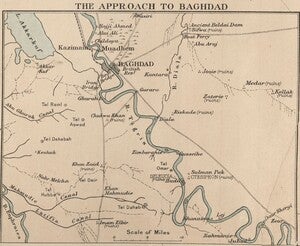Our January Map of the Month is this 1916 map of “The Theatre of War in Mesopotamia”, displaying Mesopotamia (modern-day Iraq and Syria) and Persia (modern-day Iran) as they appeared in the midst of World War I. This map was published in Edward Stanford’s War Map No. 9 and includes an inset of “The Approach to Baghdad '' as the British were in the process of a military campaign toward Baghdad at the time of this map’s publication.
After the start of World War I in 1914, the Ottoman Empire remained neutral for a short time before signing a treaty with Germany, leading the Allied powers to worry about the potential threats of an enemy Ottoman Empire. Great Britain was particularly worried about its recently acquired oil fields in Mesopotamia. In November of 1914, British troops entered the Persian Gulf and landed in Mesopotamia with a mission to protect Britain's oil fields as well as to monitor the Ottomans’ actions. The majority of these troops, as well as future British troops of the Mesopotamian campaign, came from British India rather than Great Britain itself and would go on to face incredibly harsh conditions due to their distance from Europe that resulted in shortages of both supplies and additional troops.
The Mesopotamian campaign quickly turned from a mission of protection and surveillance to one of warfare as the Ottoman Empire attacked the Russian Navy, causing British leaders to begin a military campaign with the eventual goal of capturing Baghdad. The campaign was quite successful as British troops moved up the Tigris and Euphrates Rivers and captured ports and cities like Basra and Amara as they went. However, British progress came to a halt as the Ottomans laid siege to the British troops occupying Kut-el Amara. In April 1916, the five-month long siege ended with the surrender of the remaining troops who had not yet starved to death and their transfer to Ottoman prisoner of war camps where they faced conditions similar to those in the Japanese POW camps of World War II. Due to this devastating conclusion and the British army’s inability to break through Ottoman forces even with reinforcements, the Siege of Kut is regarded as one of the greatest losses in British military history.
After the disastrous events in Kut, the British army reorganized, rebuilt, and appointed a new commander to resume the offensive campaign against Baghdad in late 1916. As shown in the inset above, British troops continued to utilize the Tigris River as they advanced on Baghdad, fighting and winning many battles along the way. They reached Baghdad in March of 1917 and in sharp contrast to the months-long experience at Kut, Baghdad fell to the British after only 3 days. The acquisition of Baghdad was a significant success for Great Britain and although there was still fighting in Mesopotamia until WWI came to an end, it was less intense than what had previously occurred. The end of the war and the subsequent Allied scramble to claim and reorganize the various territories of the Ottoman Empire (especially those of Mesopotamia) had several severe ramifications that historically impacted and continue to impact the area today.
In addition to its detailed depictions of the topography and cities of Mesopotamia and Persia, this map also incorporates many historic ruins of the prominent cities of ancient Mesopotamian civilizations. Three of the most important ruins are those of the former capital cities of Seleucia, Ctesiphon, and Babylon. Ctesiphon was the site of a major battle in the Mesopotamian campaign of World War I where British troops were driven back by Ottoman troops as they attempted to advance up the Tigris River toward Baghdad. This battle compelled British forces to return to Kut, where they went on to be trapped by the Ottoman siege.
We hope you enjoyed this month's map! As with all of our Map of the Month features, if you’d like to learn more about this map, get a scan of this map, or schedule a visit to explore our maps in person, please submit a Map and Geo Service Request. We’ll be sure to get back to you within two business days, but typically sooner.
- Kelsey Kerley, Map and GIS Assistant



